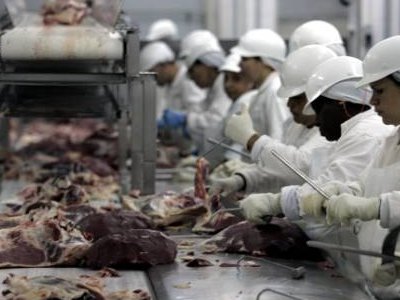
Agricultural News
Dr. Derrell Peel Investigates Fake Ag News, Sets the Record Straight on the Beef Packing Industry
Mon, 31 Jul 2017 11:14:44 CDT
 Mondays, Dr. Derrell Peel, Oklahoma State University Extension Livestock Marketing Specialist, offers his economic analysis of the beef cattle industry. This analysis is a part of the weekly series known as the "Cow Calf Corner" published electronically by Dr. Peel and Dr. Glenn Selk. Today, Dr. Peel muses on "fake news" in the media, regarding the meat packing industry and sets the record straight on ground beef production and beef packing capacity.
Mondays, Dr. Derrell Peel, Oklahoma State University Extension Livestock Marketing Specialist, offers his economic analysis of the beef cattle industry. This analysis is a part of the weekly series known as the "Cow Calf Corner" published electronically by Dr. Peel and Dr. Glenn Selk. Today, Dr. Peel muses on "fake news" in the media, regarding the meat packing industry and sets the record straight on ground beef production and beef packing capacity.
"A couple of media articles caught my eye recently. The first was an article on Yahoo entitled "Why you should think twice before getting ground beef from the supermarket". The article reveals, apparently to the surprise of the author, that ground beef is often made from the meat of multiple animals and not just from a single animal. And apparently this is a major source of food safety concern for the author, though it's not clear why.
"The fact is that ground beef is typically made from the trimmings of fed cattle combined with lean trimmings from cull cows to achieve the desired level of lean to fat in the product. Ground beef has been made this way for many years. It is also true that ground beef is inherently more risky compared to whole muscle cuts because of the increased surface area that results from grinding and the mixing of the product which increase the risk of contamination. This is true whether the ground beef is made with meat from a single animal or multiple animals. There are a variety of reasons why consumers might desire to raise or buy a single animal as the source of their beef- mostly for steak quality and consistency. I myself keep a half of beef in my freezer. However, a preference for single animal source of beef is not a legitimate reason to cast doubt on ground beef quality and safety in retail and food service markets.
"I wonder if the author also realizes that not all the lettuce in a bagged salad nor the green beans in a can are from the same plant or field or farm; not all the milk in a jug comes from the same cow; and not all the buffalo wings in a bucket came from the same chicken. To suggest that ground beef made from the meat of multiple animals is an inherent food safety threat is at least an admission of general ignorance of food systems and at most a scaremongering disservice to consumers and the industry.
"A second recent agricultural media article included the following statement: "Yet, a big part of last fall's (price) collapse was simply that we had insufficient packing capacity to handle the increase in the nation's cattle herd." No source or data was provided to support the statement. The average daily federally inspected slaughter level in 2016 was 95,913 head with a maximum daily level of 117,978 head on November 10, 2016. That was the only day in 2016 with slaughter above 117,000 head. This compares to five years earlier in 2012 when the average daily slaughter was 103,580 head and there were 225 days with slaughter above 117,000 head, including 205 days with slaughter exceeding 120,000 head.
"Beef packing capacity declined from 2012 to 2016 including the closure of a major fed cattle plant in 2013 and some smaller plant closures in recent years. Published estimates of slaughter capacity suggest that capacity utilization (average daily slaughter as a percent of slaughter capacity) increased from 79 percent in 2012 to 83 percent in 2016 for the top 20 beef packing plants. However, there is no indication that capacity constraints contributed to 2016 fed cattle market conditions. So far in 2017, daily slaughter has exceeded 117,000 head 36 times with three times in excess of 120,000 head. Despite this fed cattle prices have recovered to unexpected levels since the fall of 2016. Slaughter capacity could become a factor at some point with continued herd growth but it is unlikely to be a significant issue for the foreseeable future."
WebReadyTM Powered by WireReady® NSI
Top Agricultural News
More Headlines...





